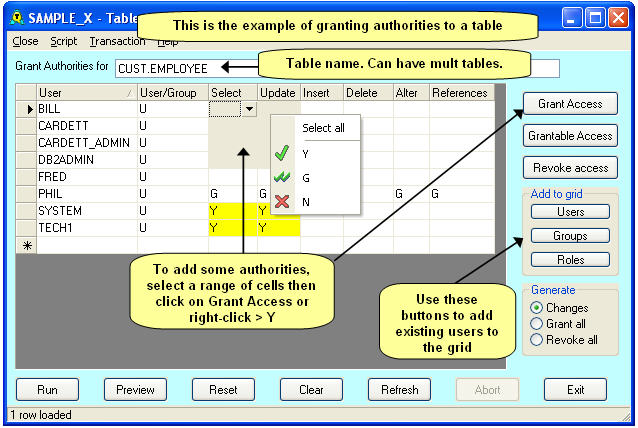This window is used for managing the authorities of your database objects. This can be used to manage authorities of many types of objects - tables, views, packages, procedures, tablespaces, plus others.
This window is part of the Administration Component of AQT.
In this section we give a basic description of how to use the window. You should also read:
As with other parts of the AQT Administration Component, the Manage Authorities window is used for many different functions and takes a different appearance depending on the function being performed and the database type.
It had three main uses:
Function |
Description |
Invoked from the Database Explorer by |
Object authorities |
Specifies which users have access to an object (such as a table) |
Selecting an object then clicking on the Manage Authorities icon |
User authorities |
Specifies what objects a user has access to |
Selecting a user then clicking on the Manage Authorities icon. This may be a drop-down list if there is more than one type of authority a user can have. |
User roles |
Specifies which users are members of which groups or roles |
Selecting a user then selecting the appropriate option from the Manage Authorities drop-down list |
The following is an example of the Manage Authorities window for managing DB2 Table authorities

These are shows as follows:
Y |
Has authority |
G |
Has GRANTABLE authority (this allows the user to Grant the authority to other users) |
N or blank |
Does not have the authority |
You can refresh the grid by clicking on Refresh.
You can change the authorities shown in the grid by any of the following methods:
As you change the authorities, the cell will change to yellow (showing that there is a pending change). Once you run these changes and they are applied successfully to the database, the cells will change from yellow to white.
Clicking on Reset will remove any pending changes.
Runs the SQL for granting / revoking the authorities you have selected. If this involves running more than one SQL statement, you will be shown the Run Multiple Statements window.
You can also run the SQL with F5.
AQT keeps track of whether each change has been run successfully. If so, the cell is taken out of pending-change status (and is changed from yellow back to white). Any changes that failed to be processed remain highlighted for you to correct and rerun.
If you are in evaluation mode of the Admin Component, this button will not be active.
Shows you the SQL that AQT will run to grant / revoke the authorities you have selected.
Removes any pending changes you have made to the grid.
This clears the existing contents of the grid. This is useful for removing the existing authorities so you can deal with the new ones you are adding.
This refreshes the data in the display. You may wish to do this after you have made a number of changes to the authorities and wish to re-display the current authorities.
Sometimes, the changes you have made will not appear when you Refresh. This can be quite puzzling. This happens because some databases have complicated rules about whether an authority is recorded explicitly against a user. See Database Specifics for more on this.
If you have added any objects / users to the grid with the Show Tables or Show Users buttons then these will disappear from the grid. You will need to click on these buttons again to add these entries to the grid.